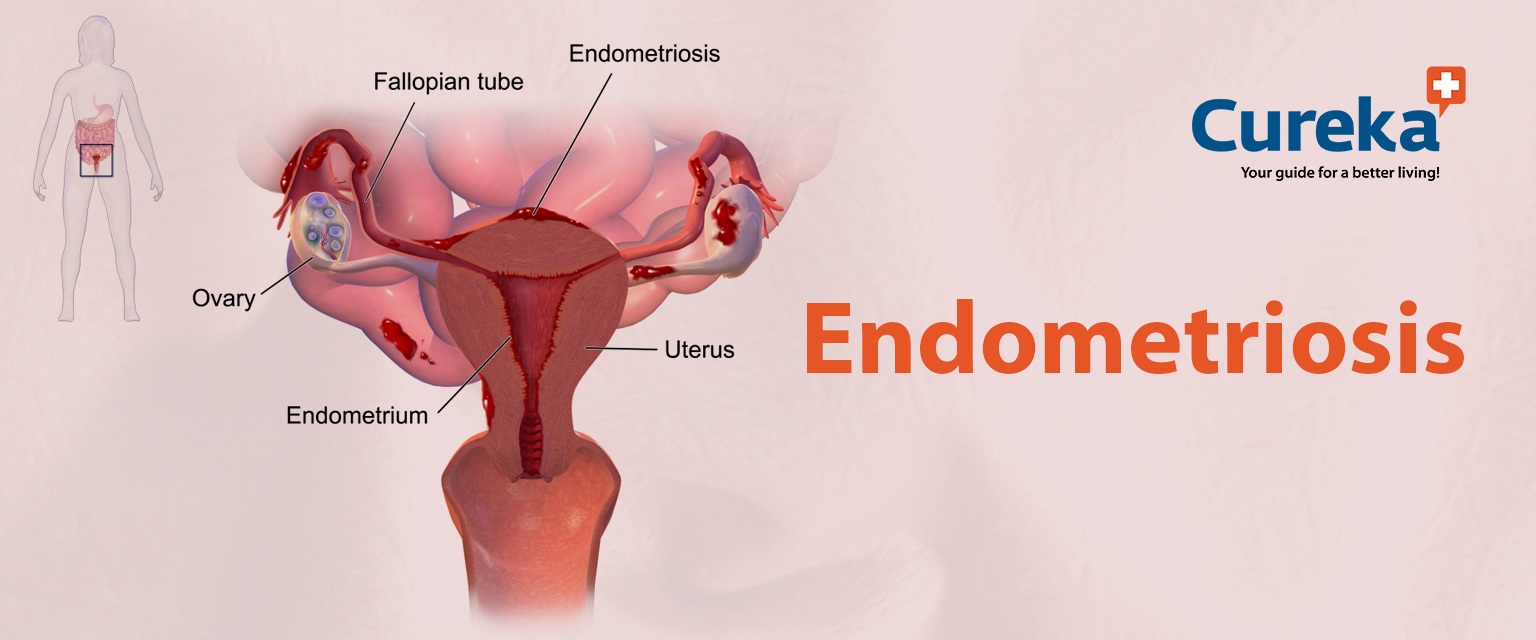Endometriosis
Endometriosis is a gynecological condition affecting 2-10% of women. This condition’s name is derived from the word “endometrium,” – a tissue that lines with a uterus.
In any woman’s normal menstrual cycle, the tissue takes shape and is discarded if the woman doesn’t get pregnant. In endometriosis, a tissue grows outside the uterus; it looks and works like endometrial tissue generally on other organs within your pelvis or within the abdominal cavity like your ovaries, bladder, and intestines.
Every month,this inappropriate tissue reacts to hormonal changes in the menstrual cycle by creating and breaking as an endometrium does, which results in minor bleeding within the pelvis. It results in swelling, inflammation, and scarring of normal tissues nearby endometriosis implants.
Causes
The endometriosis causes are still not known. One theory proposes that in menstruation, some tissue is supported through fallopian tubes in the abdomen, one type of “reverse menstruation,” in which it links and grows. One more theory indicates that endometrial tissue might travel and insert via lymphatic channels or blood, similar to how cancer cells increase. Another approach suggests that cells within any location might convert to endometrial cells.
Endometriosis occurs when tissues like a lining inside the womb or uterus grow outside your womb or uterus where that doesn’t belong. The growth of endometriosis may expand and bleed in the similar way a lining inside your uterus does each month — during the menstrual period.
Symptoms
Here are the most general symptoms of endometriosis; however, every woman might experience symptoms differently, or some might not show any signs. Endometriosis symptoms might include:
- Gastrointestinal problems like constipation, diarrhea, or nausea
- Heavy or abnormal menstrual flow
- Infertility
- Pain in intercourse
- Pain, particularly extreme menstrual cramps, which might come in the lower back or abdomen
- Painful bowel movements in menstrual periods
- Sore urination in menstrual periods
Diagnosis
For a lot of women, having an endometriosis diagnosis brings relief. Diagnosis starts with the gynecologist or any other healthcare service provider assessing a patient’s health history and completing a physical examination of the pelvis and abdomen.
An endometriosis diagnosis can only be made when the doctor does a laparoscopy, and diagnosis is made by studying the tissues under the microscope.
Laparoscopy is a minor surgical procedure where a thin tube called a laparoscope, having a camera, is inserted in the abdomen using a small cut. Laparoscopy can identify the location, extent, and sizing of endometrial growth.
Other examinations that might be used for endometriosis diagnosis include:
Ultrasound:
An endometriosis ultrasound is an imaging procedure to determine if you have endometriosis. It can show Endometrial tissue that has grown to cysts (endometriomas), Location of endometrial tissue that’s embedded deeply in an organ but can’t show the ones that are tiny or on the organ surface. If the endometrial tissue is found in bladder or intestines you may be referred to urologist or colorectal surgeon. Transvaginal ultrasounds are more advanced and can show the endometriomas on the ovaries.
CT Scan:
In CT scan image endometriomas appear as cystic masses. The appearance of this cyst, endometriomas and endometriosis on CT scans is similar to the cystic masses of pelvic inflammatory disease and benign or malignant ovarian tumours. So most Physicians don’t rely on this. But certain complication of endometriosis like bowel obstruction is evident on CT scan.
MRI Scan:
MRI is an accurate technique preferred by healthcare provider to distinguish endometriomas from other cystic masses. Because in MRI the appearance of cyst depends on the concentration of iron and protein in the fluid. MRI also diagnoses the complications of endometriosis like bowel and uteral obstructions. MRI requires longer imaging time.
Your doctor is your best adviser for deciding which imaging procedure is best for your diagnosis after pelvic examination.
Treatment
On the whole, endometriosis treatment may include:
“Watchful waiting” for observing the source of this illness
Pain medication:
Nonsteroid anti-inflammatory medicines and other painkillers
Hormone therapy:
Oral contraceptives must combine progestin or estrogen (synthetic progesterone) hormones to prevent ovulation and decrease menstrual flow.
An artificial derivative of testosterone (the male hormone)
Gonadotropin releases hormone agonist that stops the production of the ovarian hormone, making “medical menopause.”
Surgical methods that might be used for treating endometriosis include:
Hysterectomy:
Surgery for removing the uterus and ovaries.
Laparoscopy:
A minor surgery where a laparoscope, one thin tube having a light and lens, gets inserted into the incision in the abdominal wall; with a laparoscope to observe your pelvic area, a doctor can usually eliminate the endometrial growth.
Laparotomy:
An extra general surgery for removing displaced endometrium without damaging any healthy tissues
Conclusion
You can’t cure endometriosis, and it is challenging to treat. Treatment can only ease symptoms. Therefore, the condition won’t interfere with your everyday life. Treatment can only relieve pain.











